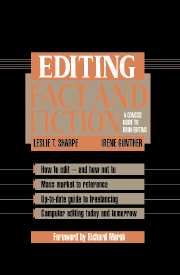Book contents
- Frontmatter
- Contents
- Foreword
- Acknowledgments
- Introduction
- Chapter 1 Who (and What) Is an Editor?
- Chapter 2 Fact or Fiction? Finding Your Niche
- Chapter 3 Principles to Edit By
- Chapter 4 The Editor's Senses
- Chapter 5 The Editor's Sensibility
- Chapter 6 A Guide to Editorial Freelancing
- Chapter 7 Electronic Editing Today and Tomorrow
- Chapter 8 Tools of the Trade and How to Use Them
- Index
Chapter 4 - The Editor's Senses
Published online by Cambridge University Press: 21 September 2009
- Frontmatter
- Contents
- Foreword
- Acknowledgments
- Introduction
- Chapter 1 Who (and What) Is an Editor?
- Chapter 2 Fact or Fiction? Finding Your Niche
- Chapter 3 Principles to Edit By
- Chapter 4 The Editor's Senses
- Chapter 5 The Editor's Sensibility
- Chapter 6 A Guide to Editorial Freelancing
- Chapter 7 Electronic Editing Today and Tomorrow
- Chapter 8 Tools of the Trade and How to Use Them
- Index
Summary
The five senses–sight, hearing, smell, taste, and feel–can all be said to play a part in the editing process. Editors with an “accurate eye” and an “ear for language” are valued by colleagues and writers alike. An editor who consistently spots bestsellers is said to have a “nose” for the market, while one with a talent for bringing out the best in authors has a “feel” for writing. And editors who sample a portion of a finished manuscript to ensure that it is up to standard are indulging in copy “tasting.”
In this chapter we use “senses” to mean the special faculties every editing professional must develop in order to be effective. Among them are the editor's “eye,” “ear,” “nose,” and common sense.
Editing is not–or shouldn't be–done in a vacuum. Ideally, editors start out with a set of general principles or basic assumptions (the kind we have articulated in Chapter 3) as well as a thorough knowledge of grammar, usage, and style. As we see it, the editor's senses serve as the vital link between principle and practice. (While all editors need to develop these special faculties, our main focus in this chapter is on the line editor and the copyeditor.)
Our discussion of how the editor's senses work in practice is not intended to provide answers to the many specific questions of usage, style, and grammar that editors confront every day. That is not the main focus of this book.
- Type
- Chapter
- Information
- Editing Fact and FictionA Concise Guide to Book Editing, pp. 102 - 129Publisher: Cambridge University PressPrint publication year: 1994



